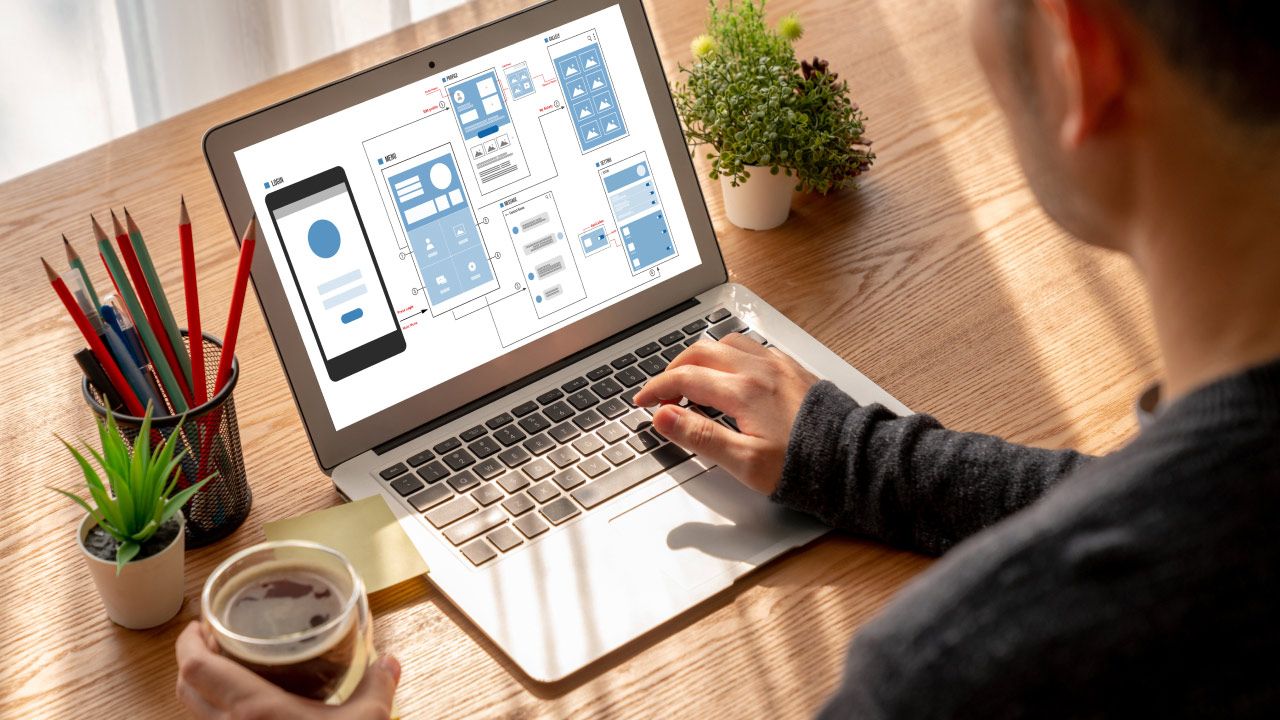UX Design Examples To Inspire UX Designers To Improve User Experience
By Marco Franzoni • May 4, 2024

Introduction: Setting the Stage for UX Design Excellence
In the digital age, the power of a well-crafted user experience (UX) cannot be overstated. UX design stands at the intersection of technology and art, blending intuitive navigation, visually appealing interfaces, and seamless interactions to not only meet but exceed user expectations. At the core of UX design lies the commitment to understand and anticipate the user's journey, transforming every click, swipe, and scroll into a meaningful narrative that resonates with the target audience.
Whether browsing through the best UX websites or interacting with mobile apps, users today demand more than just functionality; they seek an engaging, easily accessible, and beautifully designed experience. By harnessing key features such as elegant design, interactive elements, and clear language, UX designers create environments that enable users, encourage exploration, and ensure a seamless user experience from the home page to the final transaction.
As we delve deeper into the principles and examples of exceptional UX, remember that each design choice is a stepping stone towards creating content tailored to the individual user—content that not only helps users focus but also makes the entire process a delight. This is what sets great UX apart: a commitment to enriching user interaction, simplifying complex processes, and ultimately, crafting experiences that are not just usable but truly memorable.
What is UX (User Experience)?
User Experience (UX) is the essence of how individuals interact with and experience a product, system, or service. It encompasses every aspect of the user's interaction with a company, its services, and its products. The primary goal of UX is to ensure that users find value in what you are providing to them. This is achieved by designing each element of the UX to meet the specific needs of the user in the most effective way possible.
A seamless user experience is built on a deep understanding of user needs, behaviors, and expectations. It involves thorough user research, testing, and feedback to create a design that is not only visually appealing and intuitive but also fully functional and responsive to user interactions. Great UX design prioritizes the user’s journey through the interface, ensuring every touchpoint—from the landing page to complex navigation—is crafted to enable and encourage users to proceed with ease and confidence.
By integrating user expectations with brilliant UX design, designers strive to create a seamless, engaging, and memorable experience that resonates deeply with users, making every interaction count.
What is the role of UX in web design?
In web design, the role of User Experience (UX) is pivotal, shaping how users perceive and interact with a website. It extends beyond mere aesthetics to encompass the entire user interface, making it both visually appealing and highly functional. The essence of UX in web design lies in creating an intuitive, seamless user experience that effortlessly guides users through a website's content and features.
UX design focuses on understanding the user's journey from the initial landing page to the final interaction, whether it's making a purchase, signing up for a newsletter, or reaching out through a contact form. By prioritizing user-friendly design elements and interfaces, UX ensures that the website is accessible, easy to navigate, and responsive to the needs of diverse users. This approach not only satisfies users but also drives engagement and conversion, reinforcing the importance of UX in building successful digital platforms.
Ultimately, UX in web design is about creating an empathetic digital environment that anticipates and responds to user needs, fostering positive interactions and enabling users to achieve their goals with ease.
UI vs UX Design: Understanding the Differences
While often used interchangeably, UI (User Interface) and UX (User Experience) design play distinct but complementary roles in creating a digital product. UI design focuses on the aesthetic elements of an application or website, including the layout, visual design, and interactive elements that contribute to the look and feel of the product. It's about ensuring that the interface is visually appealing, coherent, and tailored to the target audience, enhancing the overall feel and usability.
On the other hand, UX design delves deeper into the user's interaction with the product, aiming to optimize the overall experience by making it more efficient, intuitive, and satisfying. UX design encompasses a broader scope, including user research, design strategy, and usability to ensure the product not only looks good but feels good to use.
Together, UI and UX design work in harmony to create products that are not only beautiful but also brilliantly functional, ensuring that every user journey from the first touch to the last is a seamless, engaging experience. This synergy is what enables users to navigate a product effortlessly, making the complex simple and the ordinary extraordinary.
What Makes a Good UX Design?
Good UX design transcends the mere functionality of a product to deliver a seamless, engaging user experience that feels intuitive and effortless. At its heart, a brilliant UX design is user-centered, focusing on the actual needs and desires of the user. It combines key features such as usability, accessibility, and aesthetics to create an environment where users not only achieve their goals with ease but also enjoy the journey.
The hallmarks of good UX include a deep understanding of user behavior, which is gleaned from comprehensive user research and testing. This insight informs the design process, ensuring that every element, from the landing page to the navigation, is optimized for user control and interaction. A great UX design is often invisible to users because it feels so natural; it guides users through a few clicks, helps them focus on relevant information, and encourages them without barriers or frustrations.
In essence, good UX design is about creating an elegant, beautifully designed interface that is not only visually appealing but also profoundly functional and responsive to the individual user’s needs, setting the stage for a truly seamless experience.

Get Inspired with 6 Examples of Great UX Design
Calm: Emotional Empathy and User Delight
Calm’s UX design stands out through its focus on emotional empathy, creating a tranquil interface that enhances user delight. The minimalist design with soothing colors and simple navigation intuitively guides users through a calming experience, helping them to easily access meditation tools and sleep aids. The seamless experience fosters relaxation, precisely meeting the user's need for a stress-reducing application.
Netflix's Autoplay Feature
Netflix revolutionized content consumption with its autoplay feature, a brilliant example of UX design that anticipates user needs. By seamlessly playing the next episode, Netflix keeps users engaged without the hassle of manual selection, creating a binge-watching phenomenon. This feature not only enhances user delight but also demonstrates how anticipating user behavior can lead to a more addictive user interface.
Twitter's Accessibility in Product UX
Twitter has significantly improved its product UX through enhanced accessibility features, such as alt-text for images and customizable display settings. These features enable users with various disabilities to navigate the platform more easily, demonstrating Twitter’s commitment to inclusivity. By prioritizing user needs and control, Twitter enhances usability for all, showcasing a key aspect of great UX design.
Nike's Selling Experience
Nike’s selling experience exemplifies great UX design through its intuitive navigation and personalized user interactions. The website uses customer data and previous interactions to suggest products, tailored content, and encourage users through their buyer’s journey. This proactive approach not only creates a seamless user experience but also effectively guides users toward making purchases, demonstrating the power of UX in e-commerce.
Zoom's Simplified User Interface
Zoom’s user interface is a testament to the importance of simplicity in UX design. The clean, easily accessible interface allows users of all technical skill levels to initiate and join meetings with just a few clicks, eliminating common barriers to entry. This design choice has been crucial in Zoom’s adoption across various demographics, highlighting how great UX can expand a product’s reach.
Airbnb: Simplicity and Flexibility
Airbnb’s website combines simplicity with flexibility, offering an elegant design that caters to a wide range of vacation rentals and user preferences. The intuitive navigation and search filters enable users to find accommodations that meet their specific needs efficiently. The UX design emphasizes user control, allowing for a personalized browsing experience that enhances satisfaction and user trust.
Each of these examples showcases how great UX design goes beyond aesthetics to create functional, intuitive, and delightful user experiences. By focusing on user needs, these companies have crafted interfaces that not only meet but exceed expectations, setting benchmarks in their respective industries.
Learning from the Best: UX Website Analysis
Best UX Websites
The best UX websites exemplify the integration of brilliant UX design with functional usability and aesthetic appeal. Sites like Airbnb and Apple stand out for their intuitive navigation and elegant design, which guide users effortlessly through their offerings. These websites utilize a clear, visually appealing layout that enhances user interaction and fosters a seamless experience.
Best User Experience Design Websites
Websites acclaimed for their user experience often prioritize user testing and feedback to refine their interfaces. For instance, Google and Amazon demonstrate how continuous improvements based on user research and behavior can lead to highly optimized UX designs. These platforms engage users by providing easily accessible content and customization options that cater to individual user preferences.
Websites with Great User Experience
Sites with great user experience go beyond functional design to create emotionally resonant interfaces. For example, Spotify and Netflix customize user interfaces based on individual user data, thus creating a highly personalized and engaging experience. Their use of key features like algorithm-driven recommendations and easy navigation allows users to enjoy a tailored service that feels both intuitive and responsive to their entertainment needs.
Through these examples, it becomes evident that the best UX designs are those that combine usability, aesthetic appeal, and innovative features to create a comprehensive and engaging user experience. These sites not only meet the basic needs of users but also enhance their overall online interactions, setting a high standard for what constitutes a great UX in the digital landscape.

Key Elements of Stellar UX Design
Anticipating User Needs
Anticipating user needs is foundational to stellar UX design. By understanding and predicting what users might require at each step of their interaction with a product, designers can create more intuitive and user-centric interfaces. This involves using user research and data to guide design decisions, ensuring that the user experience is seamless and highly responsive to user expectations.
Calm's Sign-up Flow Minimizes Users' Cognitive Load
Calm's sign-up process is a prime example of UX design that minimizes cognitive load. The design is simple and intuitive, requiring only a few essential steps to get started. This approach not only makes it easier for new users to begin using the app but also reduces the potential for frustration or confusion, enhancing the overall user experience and encouraging continued use.
Glovo's Great Navigation
Glovo's navigation system exemplifies great UX design by allowing users to find what they need quickly and efficiently. The app uses clear, visible categories and a search function that is easy to access and use, reducing the time it takes for users to locate their desired products. This kind of intuitive navigation is crucial in delivering a seamless user experience that meets users' needs without unnecessary complexity.
These elements—anticipating needs, reducing cognitive load, and ensuring intuitive navigation—are crucial in crafting a UX design that is not only functional but also delightful. They demonstrate how understanding the user's interaction at a deep level can lead to a brilliant UX design that feels almost effortless to the end user.
Mobile and App UX Design Insights
Mobile Apps UX Design Examples
In the realm of mobile apps, good UX design is crucial for success. Apps like Instagram and Uber demonstrate outstanding mobile UX by providing users with intuitive interfaces, seamless navigation, and quick access to essential features. These apps enhance user control and streamline the user journey, making interactions both enjoyable and efficient. The design is visually appealing and perfectly suited for mobile devices, emphasizing usability and user engagement.

Revolut Makes the User the UX Designer of Its App with Its Customization Options
Revolut takes mobile UX to another level by offering extensive customization options that empower users. This unique approach allows users to tailor their financial app experience to their personal needs and preferences, giving them control over everything from the interface layout to how transactions are displayed. This sense of user control is a brilliant example of good UX design, as it not only meets but anticipates the diverse needs of its users, making financial management a more personal and accessible experience.
These examples underscore the importance of user control and customization in mobile UX design. By focusing on the needs and preferences of mobile users, these apps ensure a seamless and highly personalized user experience that stands out in the competitive app market.
Good and Bad UX Design: A Comparative Analysis
Difficult or Unintuitive Navigation
Bad UX design often manifests through difficult or unintuitive navigation, where users struggle to find their way around a website or app. Such navigation frustrates users, leading to a higher bounce rate as users abandon their tasks. For example, websites that hide important links in obscure places or that require excessive clicks to reach simple information undermine user efficiency and satisfaction.
Unattractive or Outdated Visual Design
On the visual design, bad UX front is typified by unattractive or outdated designs that fail to capture user interest or trust. This might include clashing colors, small or unreadable fonts, and overcrowded layouts. In contrast, good UX design employs visually appealing elements and modern aesthetics that make interactions inviting and enjoyable. It emphasizes clean lines, coherent color schemes, and interactive elements that enhance the user interface without overwhelming the user.
These comparative examples highlight how crucial every aspect of UX design is—from how information is structured and accessed, to how it is presented visually. Good UX design not only makes a product accessible and easy to use but also appealing and enjoyable, ensuring that users not only start but also continue their journey on the platform.
Turn Inspiration into Action: Implementing Great UX Design
Transforming inspiration into actionable UX design is a journey that begins with a thorough design process. This process involves understanding the user's needs, behaviors, and preferences to create content that is not only tailored but also deeply engaging. Engaging users isn't just about catching their eye; it's about holding their attention and encouraging interaction that feels natural and fulfilling.
For instance, a great example of this can be seen in how e-commerce platforms customize their landing pages to reflect the behaviors and preferences of their users, using data to create a personalized shopping experience. This approach encourages users by making them feel understood and catered to, which in turn increases their likelihood to convert.
Furthermore, the design process must continuously evolve based on user testing and feedback, ensuring that every element, from interactive UI elements to clear, engaging content, works harmoniously to enhance the user experience. This iterative process not only helps in refining the UX but also in maintaining its relevance and effectiveness over time.
By focusing on these aspects, designers can effectively turn inspiration into action, creating UX designs that are not just functional but also inspiring, thereby fostering a seamless and enjoyable user journey.

Conclusion: The Future of UX Design
As we look towards the future of UX design, it is clear that the field will continue to evolve in exciting and innovative ways. The trends indicate a shift towards more personalized, user-centered designs that prioritize seamless experiences and engage users more profoundly than ever before. Emerging technologies such as AI and machine learning will play a pivotal role in understanding and anticipating user needs, enabling designers to create more intuitive and adaptive interfaces.
Moreover, the demand for UX designs that can adapt to a variety of devices and user environments will increase, making flexibility and responsiveness key elements of successful designs. As user expectations grow and evolve, so too will the strategies and tools at the disposal of UX designers, who will need to continuously learn and adapt to stay ahead of the curve.
Ultimately, the future of UX design is about creating connections that enrich human interactions with technology. By focusing on the user, and ensuring every design decision enhances their experience, UX designers can create digital environments that are not only functional but truly transformative.